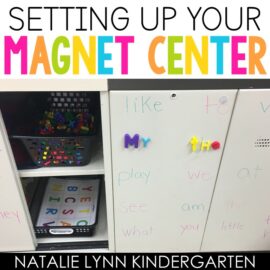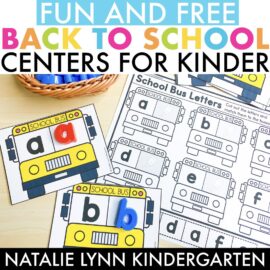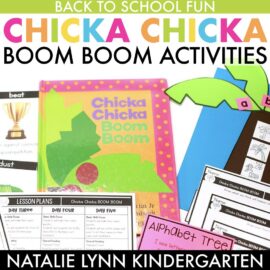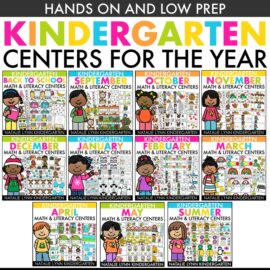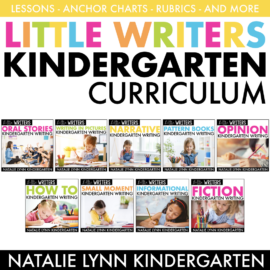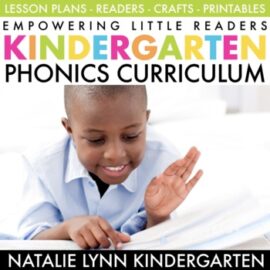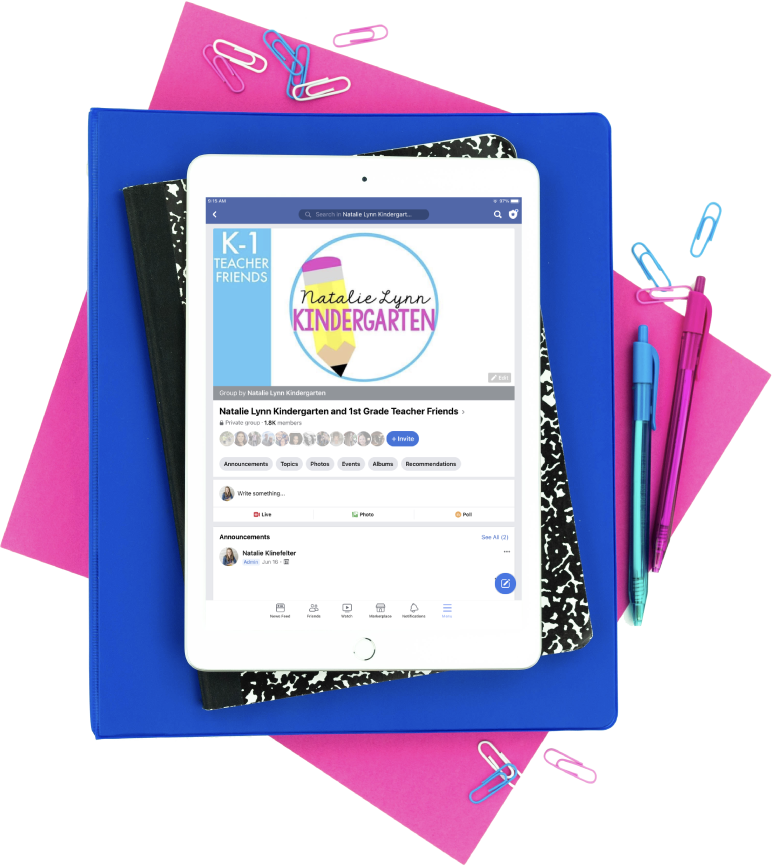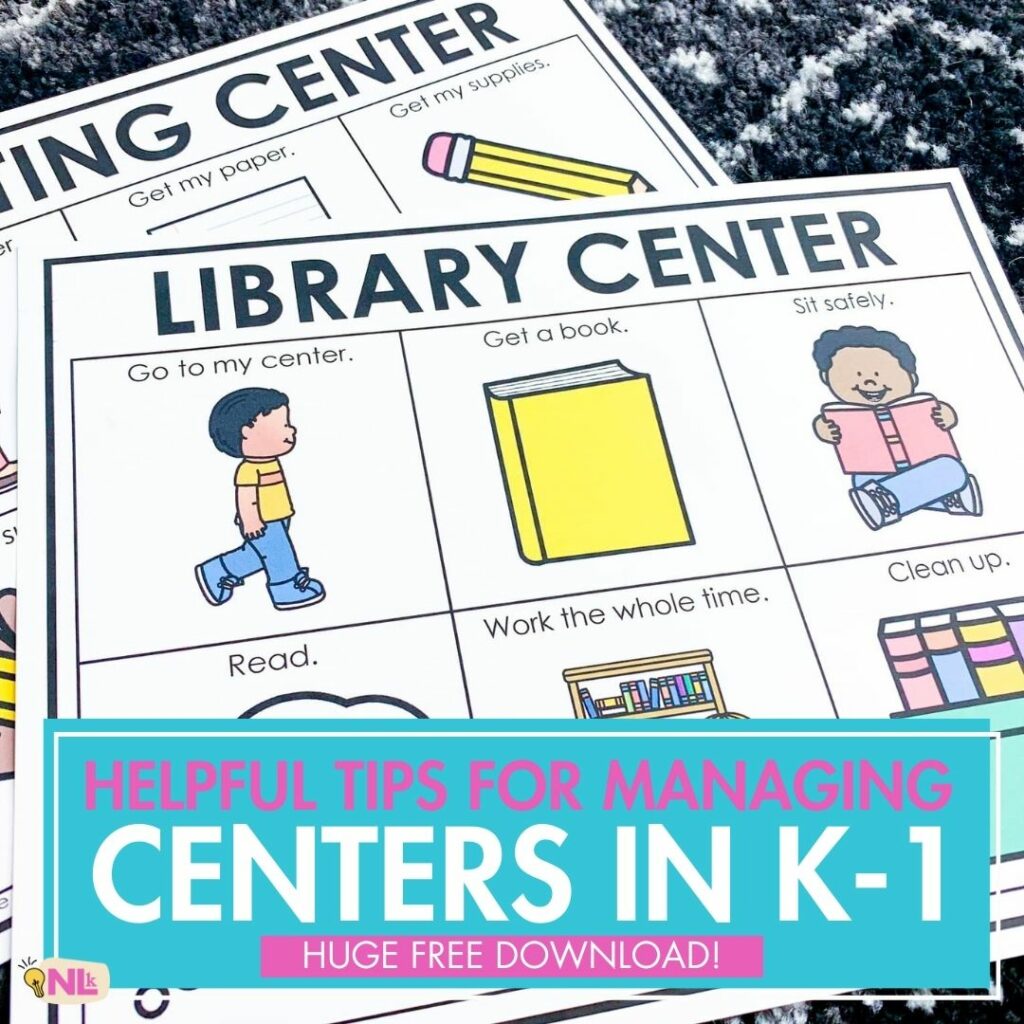
In this blog post: Are you starting centers in kindergarten or first grade? Wondering how in the world to manage the chaos? This blog post is packed full of helpful classroom management tips for centers and free centers classroom management resources to make math and literacy centers a success!
There are two types of Kindergarten (and first grade) teachers in the world: the ones who are filled with dread at the thought of math and literacy centers and wouldn’t touch them with a ten foot pole…
and the ones who have figured out how to manage the chaos to the make centers the best part of their day.
I’ll admit, when I was starting centers as a brand new kindergarten teacher, I was terrified. How would I manage 28 students all spread out and doing 28 different things?
But once I learned the best tips for managing centers in kindergarten, it quickly became our favorite part of the day.
Today I’m sharing my top 12 tips for managing centers in kindergarten and first grade, plus you’ll be able to grab a HUGE free classroom management resource for centers to get you started.
What are the benefits of centers in K-1?
You might be thinking, do I even really need math and literacy centers in kindergarten and first grade? And the answer is, no, you absolutely could teach everything whole group all day long. However, you’d be missing out on some of the amazing benefits of centers in the classroom!
Benefits such as:
- The ability to differentiate practice: During math and literacy centers, you have the ability to differentiate the activities that each group works on. That means that students can practice and review the skills they actually need to work on.
- The ability to further differentiate instruction: While your students are at centers, you are able to pull students for targeted small group instruction. This means that every students can receive direct instruction exactly where they are.
- Increased independence: If you’ve ever taught kindergarten at the beginning of the year, you know that it can feel like your students need help with every. little. thing. However, centers is a great time to practice and promote independence and problem solving.
- Combining learning with play: Research shows us that students’ brains are wired to learn through play. However, it can be nearly impossible to add play into our days! Classroom centers allow students to practice academic skills in a way that still feels like play.
Tips for managing centers in the classroom
So now that you know some of the benefits of classroom centers, it’s time to start thinking about how you will manage those centers.
Picture this: All of your students are spread out around the classroom engaged in meaningful work. The buzz of focused learning is in the air; excited but not too disruptive. You can actually enjoy this moment because everyone is working together to make sure the time runs smoothly.

Ok, this might seem like a dream. But it’s a possibility when you take the time to establish strong classroom management expectations and routines upfront for your classroom centers.
These 12 classroom management tips will help you do that.
Tip 1: Don’t start centers right away
At the beginning of the school year, it can be tempting to hit the ground running. After all, you’re missing out on valuable instructional time and, if you could just get students into centers, you’d be able to start pulling your small groups asap.
Unfortunately, this is a recipe for disaster. Take it from me….
The faster you get your students into centers and start pulling small groups, the more time you’ll waste when you have to stop to teach those expectations again and again… and again.
Start slow now to go fast later.
Make the commitment now to spend more time establishing procedures and routines upfront.
In kindergarten, I always recommend at least 5-6 weeks to fully introduce and practice routines and centers before you begin pulling small groups.
In first grade, you may be able to get fully into centers and start pulling your small groups sooner, but don’t make the mistake of thinking you don’t need to spend much time practicing upfront.
Tip 2: Introduce the expectations for each center
Centers is a skill, the same as math and phonics. Instead of thinking of centers as one overall thing you need to teach, consider that it is actually like a block tower. In order for it to stand strong on its own, it has to have a strong, solid foundation of smaller blocks.
In order to build that strong foundation, we need to teach and practice the expectations for each individual center.
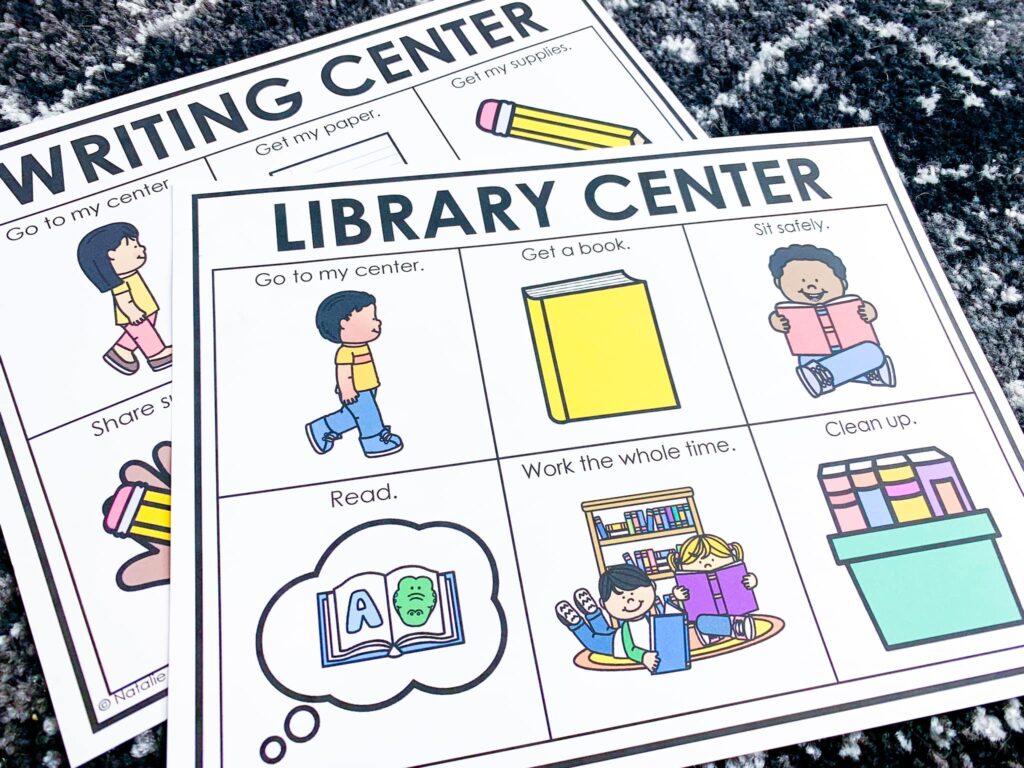
For example, the first center I introduce each year is the classroom library. I like to start with this center because it’s open ended and it gives students something to do if they finish work early those first weeks.
I bring my entire class over to the library, and we discuss what the expectations for that area looks like… and what they don’t look like. I model this and then I let students model it.
Then, I call a few students at a time to get a book and take it around the room. We practice sitting and reading those books with care, and swapping them out for new books.
You don’t have to spend much time on this at first! In fact, I recommend keeping this only a few minutes long.
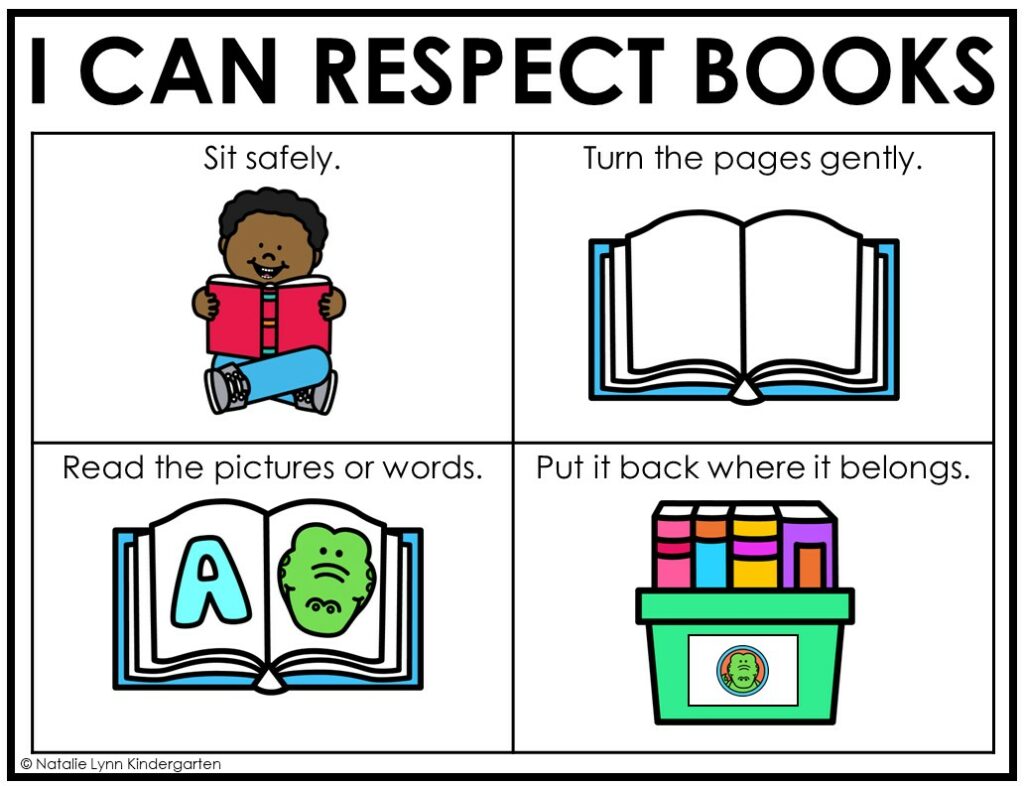
However, you will want to revisit those expectations each day at the beginning of the year and practice again and again and again. You may even stop multiple times throughout the day to practice!
For centers like the writing center, you may not be able to fit all students at the writing center to practice.
Instead, we practice some of the writing activities together whole group. For example, I may project a labeling page and model using the vocabulary cards to label the pictures.
Then, I can project the vocabulary cards and the entire class can practice completing a labeling page. (If you have students who have trouble labeling on their own, my Ultimate Writing Center includes differentiation options like having printed words they can trace instead).
Tip 3: Teach expectations for supplies at each center
Before you give students access to supplies at each center, you will want to teach them specifically how to use those supplies (and how not to use them).
For example, it can be fun to have a variety of writing tools out at the writing center. But it can also quickly become a mess of broken and lost supplies!
Model for students how to use each supply correctly and how to put it away.
Similarly with supplies like magnetic letters, dice, or playdough. Model how to use them and how not to use them. Be clear with students what will happen if they use those supplies incorrectly.
Then, be firm in this expectation at the beginning.
Don’t give students multiple warnings to use a supply correctly. At least not at the beginning of the year. Instead, as soon as a student misuses a supply, or at most after one redirect, they lose that supply until you have a chance to reteach it and practice it with them. This could be immediately, or it could be the next day.
It may feel like you’re being too strict upfront. After all, our students are little!
But the truth is, our students thrive on boundaries, and they are going to test them to see what those boundaries really are.
The stricter you are upfront, the more established those boundaries will become and you’ll be able to loosen them over time.
Tip 4: Teach overall center expectations
Once your students have learned how to use the individual centers, it is time to practice classroom centers overall.
Just like when you introduced each individual center, you will want to be clear about your expectations during centers time overall. What does it look like? What does it sound like?
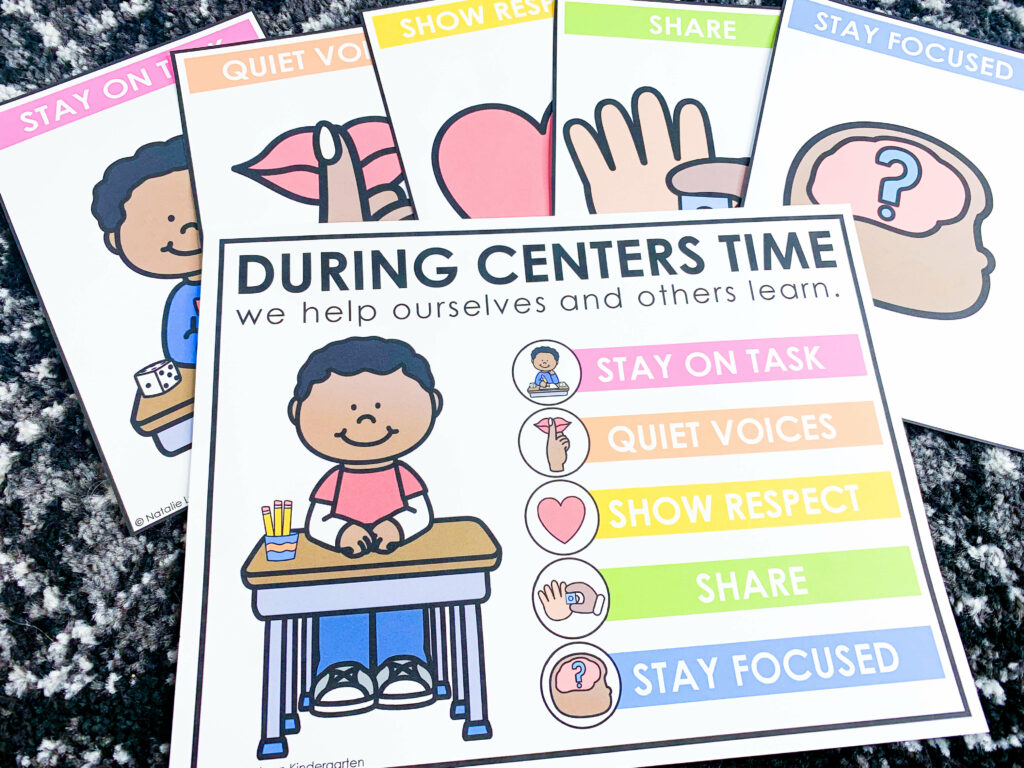
Then, practice, practice, practice!
Give students plenty of opportunities to practice classroom centers with you there as support. Which brings me to my next tip:
Tip 5: Keep practice short
At least at the beginning of the year, our students don’t have the attention span or stamina for a full hour, or even half hour, of centers. Asking our students to work beyond their stamina is a recipe for meltdowns and stress.
When you practice your centers time at the beginning of the year, keep that time short. In Kindergarten, that will be only a few minutes at first!
I explain to students upfront that we are working on building up our stamina for centers. At first we will only work a few minutes at a time, but we will quickly grow our center muscles.
A great way to measure the time students are working is by using music. We start out working the length of one Kidz Bop song.
You can slowly add in more songs as students’ stamina grows.
Now, you might be thinking, if we only work for a few minutes, won’t it take FOREVER to get into centers full time?
But the truth is, students grow that stamina quickly as they learn the routine. You can also practice multiple times in a day! You don’t have to stick to just the traditional centers time.
We will often practice centers in the morning, go to recess, come back and practice centers, do our phonics lesson, go to lunch, practice centers, do writing, go to recess, practice centers….
You can see how those practice sessions can really build up throughout the day!
Tip 6: Have a signal for transitioning or cleaning up
When you use traditional center rotations or you have free flowing centers like me, you will still want a signal that tells students when it is time to clean up and transition.
This can be transitioning to the next center or transitioning to the carpet because centers time is over.
In our classroom, the signal to clean up and transition to the carpet was a specific song. As soon as that song came on, students knew to start cleaning up and come to the carpet without me having to say a word.
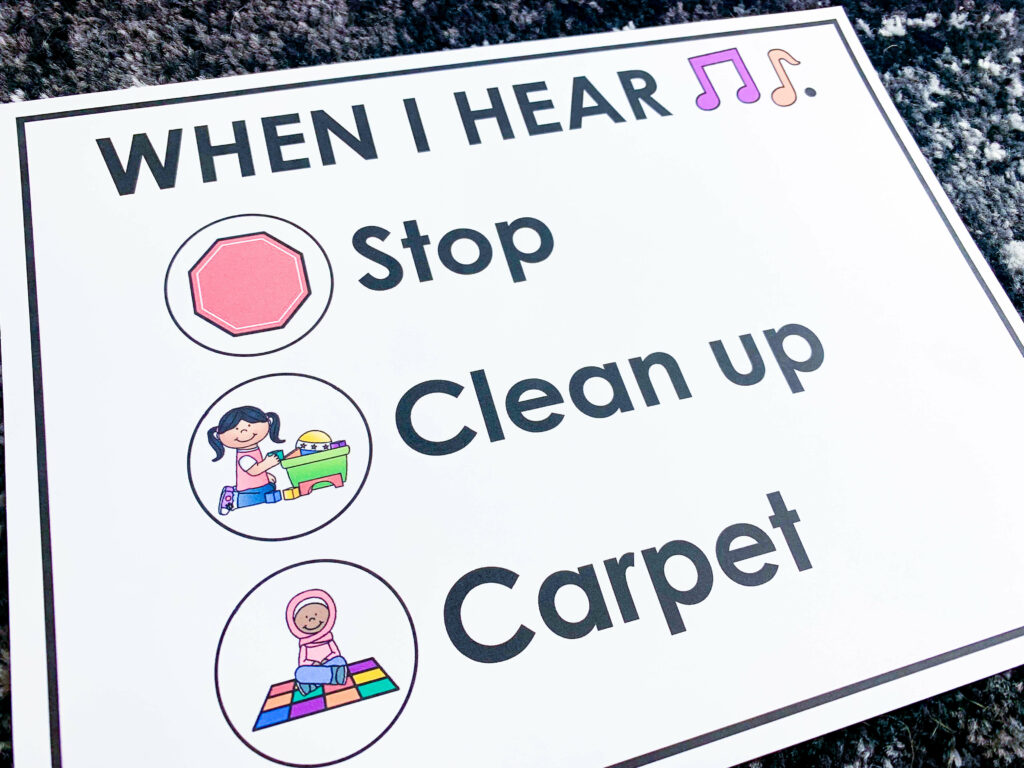
If you go that route, make sure to choose a song that you REALLY like because you will hear it a lot!
Now, in order for this transition signal to work, you will need to – say it with me – practice, practice, practice.
We start practicing this the first week of school and make a game of it! Can students beat the song by getting cleaned up and back to the carpet before it’s over?
Tip 7: Prepare for things to go wrong
As you’re teaching and practicing centers, and then even for the rest of the year after, plan on things going wrong. Because we teach 5 and 6 year olds and things WILL go wrong!
That’s when we use our “classroom reset.”
When centers start getting a little too chatty, students start getting off task, etc., I have everyone leave everything right where it is and come back to the carpet.
We talk about what happened and how we can fix it. Then, we hit the “reset button” and immediately go back to try it again.
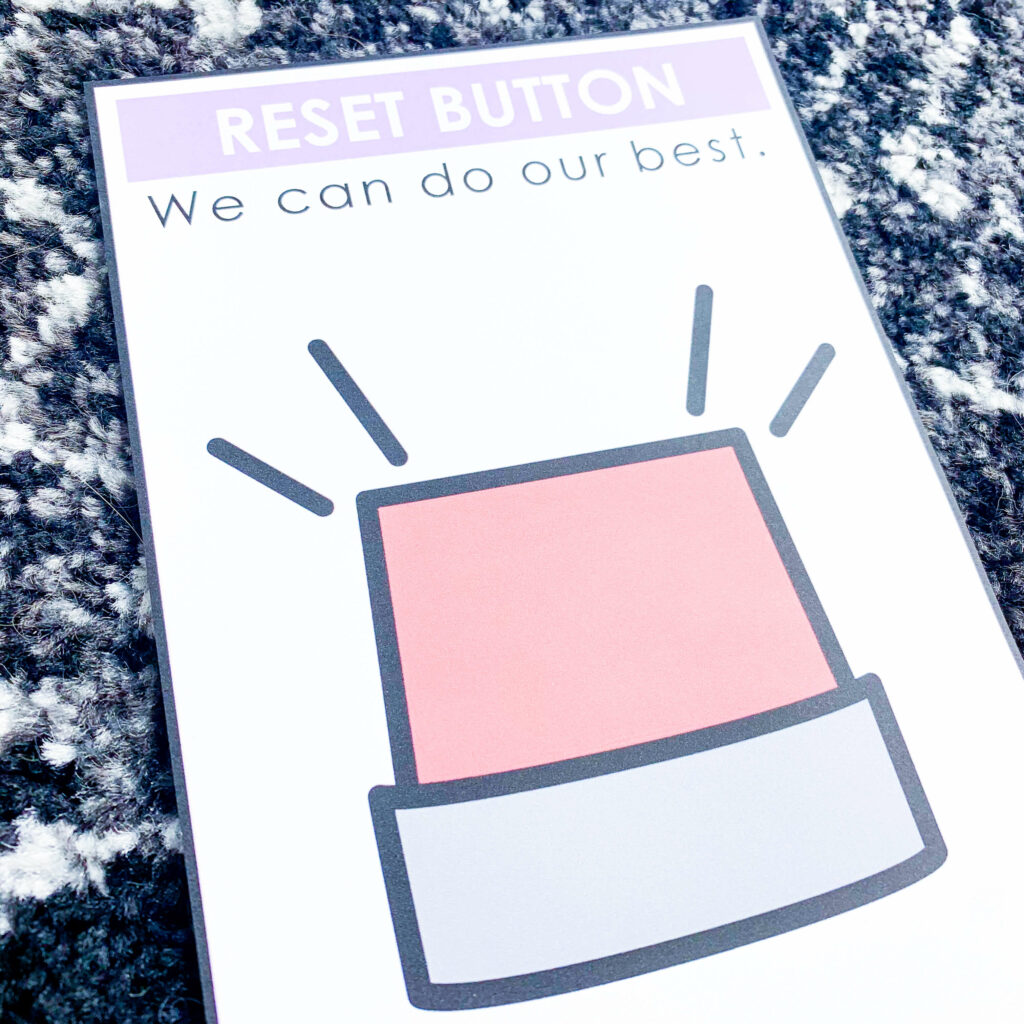
At the beginning of the year, you may find yourself resetting quite a bit. It may even get to the point where you’re getting frustrated at how often you are coming back to reset.
But don’t let that frustration show! Each time you come back, just matter-of-fact go over what happened, what needs to happen, and encourage students to try it again.
Then, PRAISE the awesome work you see. Go overboard with the praise on how students are sitting, focusing, working quietly, etc. This can be as simple as saying “I notice students sitting safely! Awesome. I notice Kayden and Lila focusing. Nice!”
I promise you, students will get sick of resetting. They will also LIVE for being noticed! So if there is a student that is having trouble focusing or following directions, be sure to notice all of the little on-task actions and point them out.
Tip 8: Have a plan for students who finish early
We all have those students who are as slow as molasses and could take the entire hour to complete one activity, even though they’re focused the entire time. They’re just meticulous!
Alternatively, we also have those students who finish in minutes and are ready to move on. For these students, we need a plan.
Some ways to manage students finishing their work early include:
- Plan open-ended centers.
- Make sure their work is challenging enough.
- Have options for if they do finish early.
For students who finish their work early, your options may be as simple as:
- Do the center again.
- Get another center activity.
- Read a book from your book box.
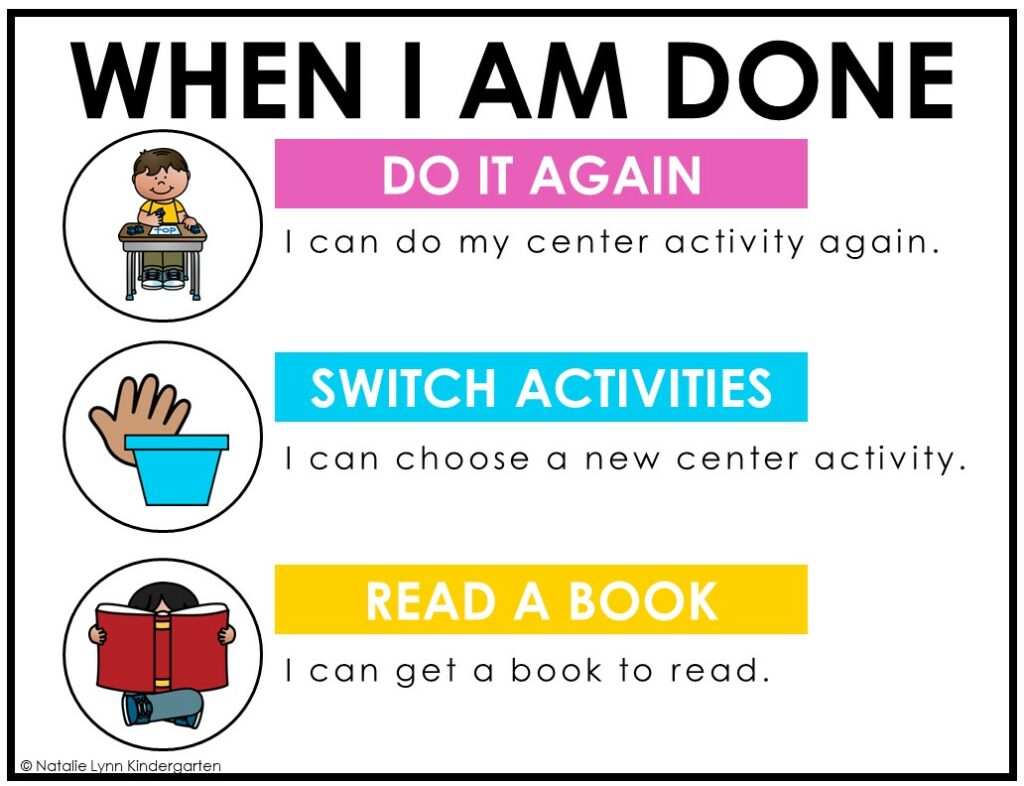
Those were my options and they worked just fine! However, you can also have an entire menu of options for early finishers to choose from.
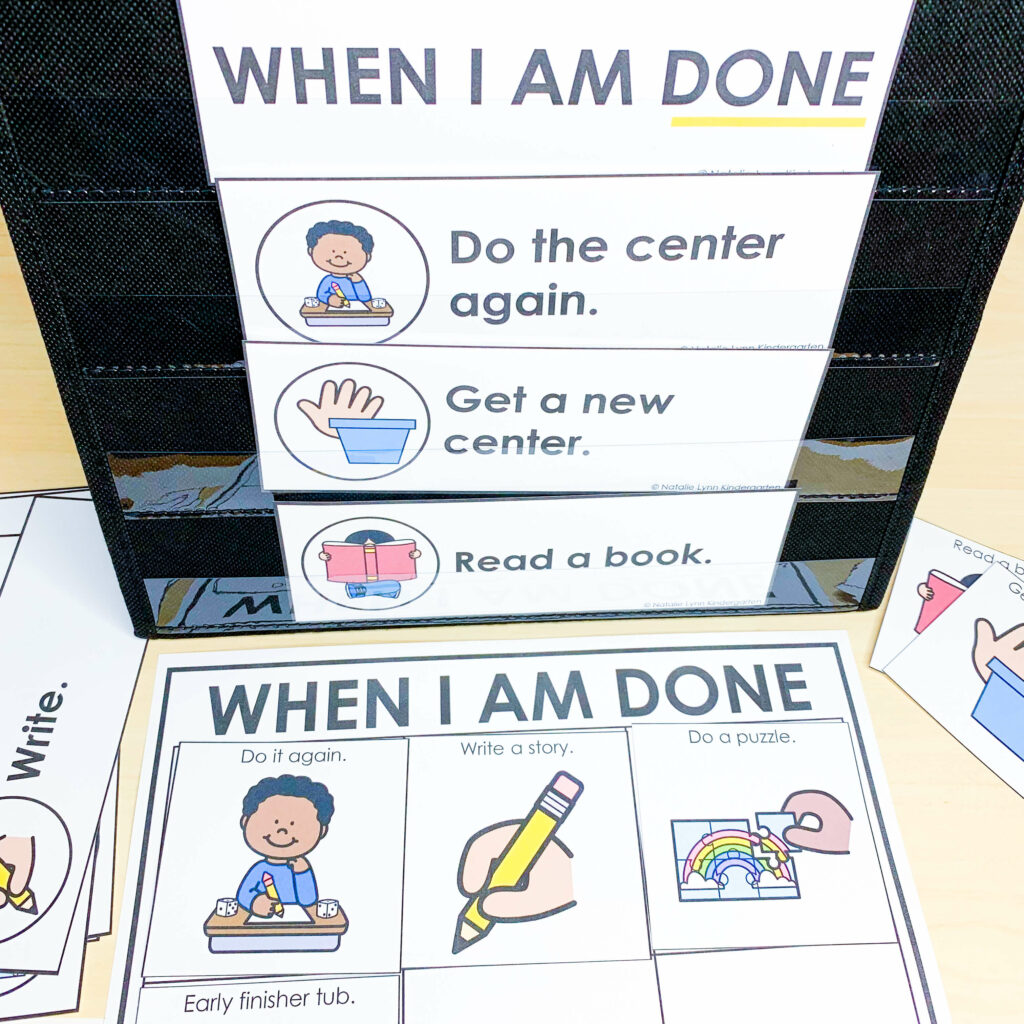
In the free centers classroom management printables, you will find options to create an early finishers menu or pocket chart list.
Tip 9: Teach students how to turn in their work
Whether you have students turn in their work for you to check or have them turn it in to their cubbies, it can quickly become a graveyard of no name papers and scraps.

Use a checklist and teach students how to check their work before turning it in. You can even keep special highlighters by your turn in backet for students to highlight their names, or supplies for them to fix their work.
Tip 10: Teach students how to help themselves
One your students begin to get comfortable with the centers routine and build their stamina, you will want to turn your focus to teaching them how to help themselves.
How many times have you been trying to meet with a small group but felt like you were getting pulled in a thousand different directions?
Teach students where to get supplies, what to do if they finish early, and how to get help from a friend.
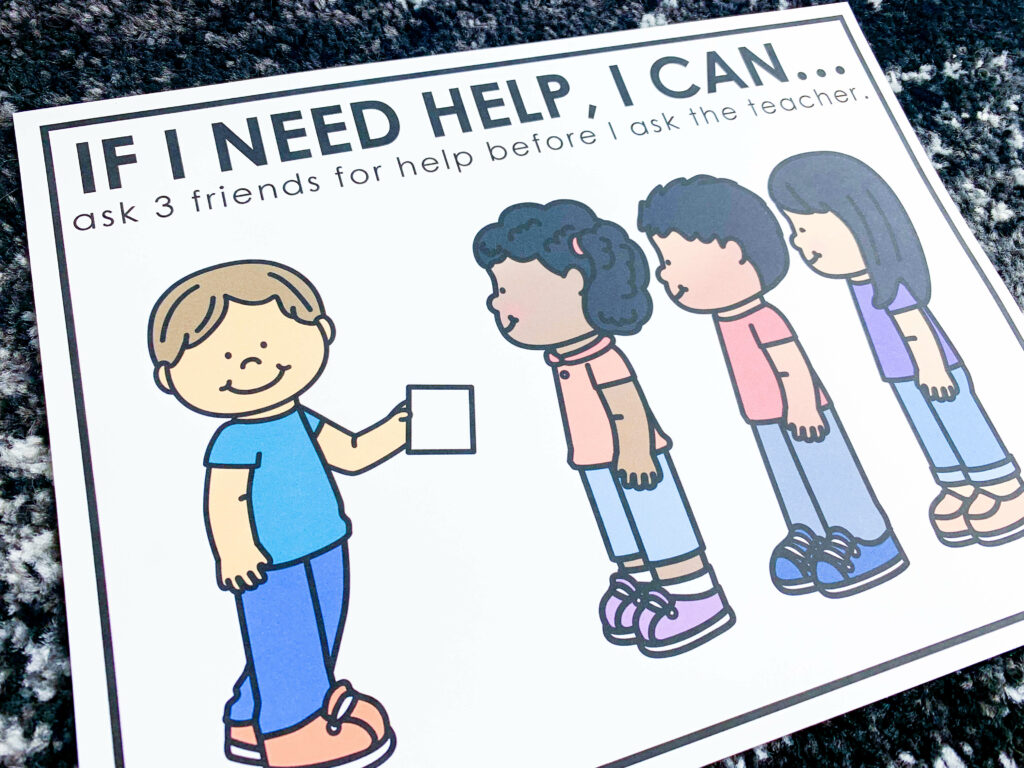
Before you are unavailable in your small groups, have students practice as if you weren’t there.
If a student comes up to you during this time, redirect them: Where can you get that? What can you do if you finish early? Who can you ask for help?
When you finish your centers time, make sure to point out students who you noticed helping themselves during your centers time.
Tip 11: Dip your toe into small groups.
When you think you are ready to begin pulling small groups in your classroom, start by dipping your toe in.
Tell students exactly what you will be doing: “Today I will start pulling small groups to my table. It will be very short today, just to introduce you to our small groups table. During this time, I will be unavailable. What can you do if you need help?”
Then, start off by pulling small groups to your table for only a minute or two at a time.
Just introduce them to some things they will find at your table, the expectations of the table, and possibly do a quick activity together.
This will give the other students in your classroom some time to get used to the disruption of having you pull a small group, and also to get used to you not being available.
If students do interrupt you, you won’t be stressed that you’re missing out on an important small group lesson.
Note: You will want to be firm about redirected any students who come to your table. If you allow disruptions at first, it will only continue.
You may also want to stop the class after you pull your first group, come back to the carpet, and discuss. Point out what went well – I noticed students staying focused, even though I was pulling this group! I noticed that Tim asked Jill for help. You worked quietly which allowed our small group to focus. Keep it up!
Tip 12: Set classroom goals
Setting classroom goals can be a powerful motivator in kindergarten and first grade. Once you get into the swing of centers, you can set individual goals or a goal for overall behavior during centers time.
Individual goals would look like: We can stay focused during centers, or We can clean up everything after centers.
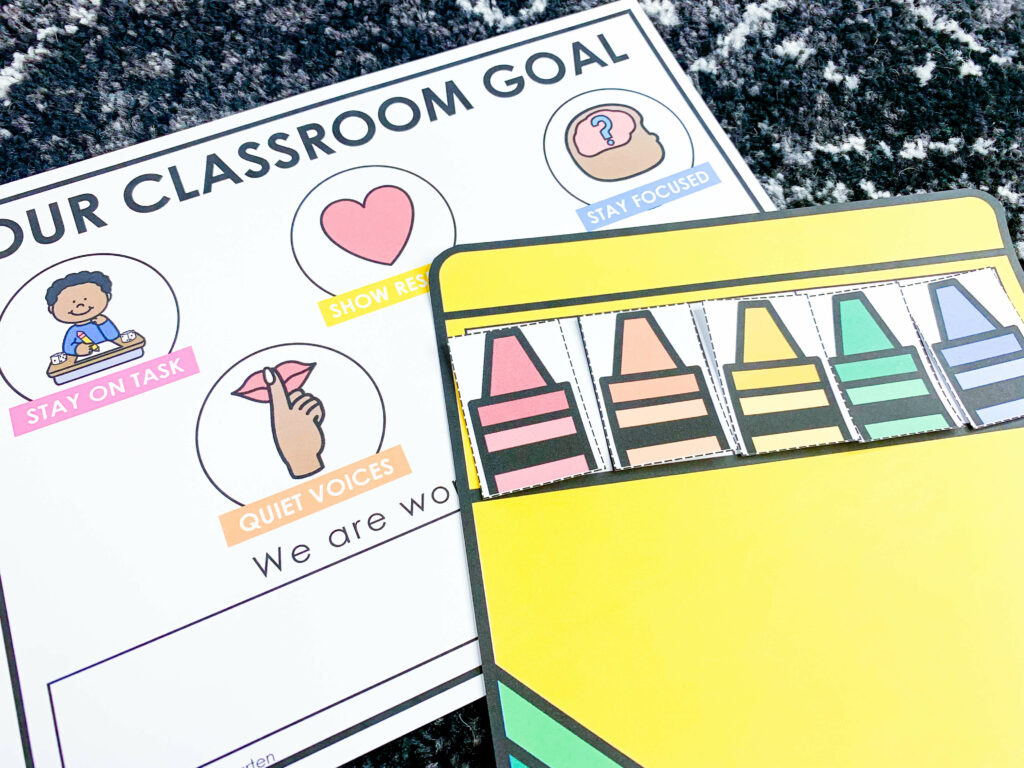
When we do individual goals, they are based on things we notice that we need to work on. Usually, at the beginning of the year, I choose the goal and I make sure that students are successful in order to create buy in. Later on, I let students vote on the goal.
Then, track your goal daily! Students can work to earn extra recess or something special like a pajama day.
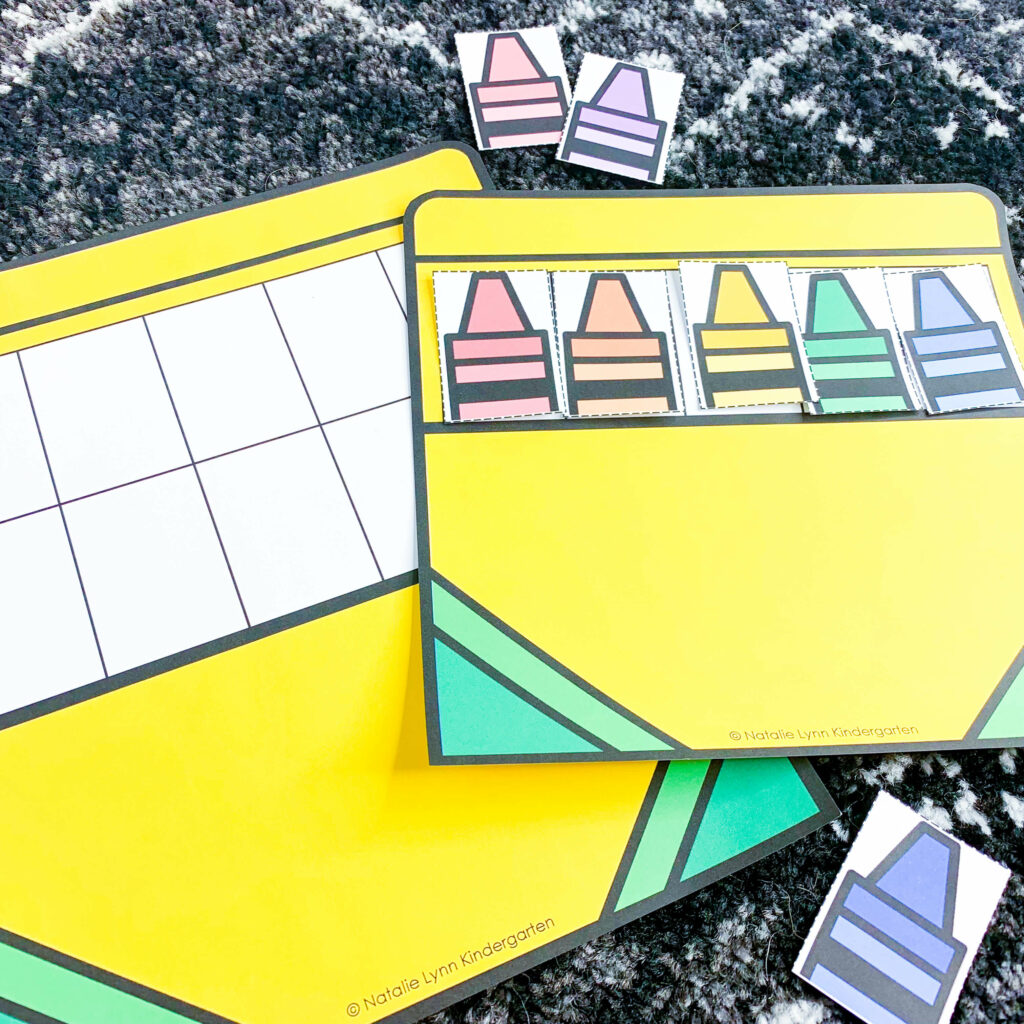
Free Centers Classroom Management Resources
As you start planning for classroom centers this year, I hope you’ll keep these tips and ideas at the front of your mind. You can get all of the printable resources shown in this blog post and more in this free centers classroom management resource.
Inside, you’ll find:
- Centers expectations
- Expectation posters for individual centers
- How to treat a book poster
- Classroom transitions poster
- The reset button
- If I need help posters
- Early finisher posters and charts
- Voice level posters
- Check your work posters
- Classroom goal posters
- Classroom goal trackers
Just hit the button that says Send It To Me! and enter your email to get the free centers classroom management resources sent straight to your inbox.
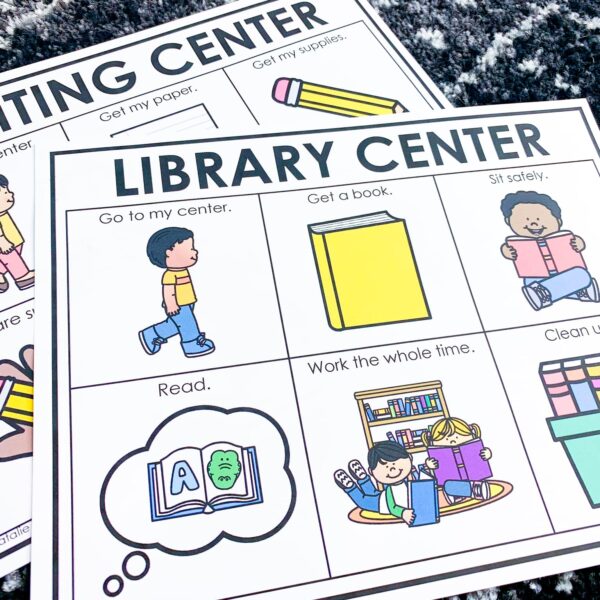
Do you love free stuff?
Classroom Management Resources for Centers
This HUGE free classroom management resource is packed with printables to help you manage the chaos of classroom centers in preschool, pre-k, kindergarten, and first grade.
Still have questions about centers? Join our Teacher Facebook Group and let’s chat!
Natalie Lynn


